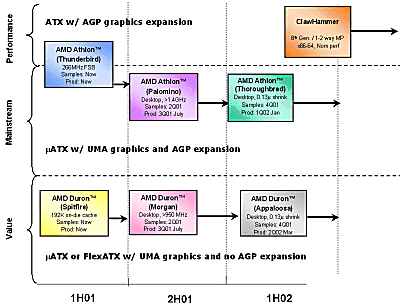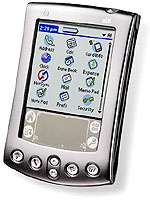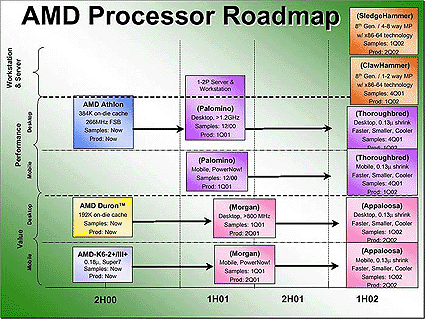Heise Online meldt dat de desktop versie van de AMD Palomino processor in tegenstelling tot eerdere geruchten niet eind deze maand op de CeBIT geïntroduceerd zal worden. Hoewel er momenteel al wel samples van de Palomino worden getest bij mobo- en chipset fabrikanten, moeten we volgens een nieuwe roadmap update nog minimaal tot het eind van het tweede kwartaal wachten alvorens de nieuwe Athlon core op de markt komt. De Palomino's zullen beginnen op een kloksnelheid van 1,4GHz en een FSB van 266MHz. De 1,3GHz Athlon, waarvan we de release waarschijnlijk wel op de komende CeBIT kunnen verwachten, zal derhalve nog gebaseerd zijn op de oude Thunderbird core:
Die nächste Generation des Athlon-Prozessors mit Codenamen Palomino wird AMD erst im Juni verkaufen, wie aus einer der c't-Redaktion zugespielten Roadmap hervorgeht. Samples liegen schon jetzt bei den Mainboard- und Chipsatz-Herstellern, doch in den Handel gelangen die Prozessoren wohl frühestens Ende des zweiten Quartals. Der Palomino erscheint mit Taktraten ab 1,4 GHz und einem Frontside-Bustakt von 133 MHz (FSB266).
In het artikel wordt niet genoemd welke verbeteringen de Palomino core - afgezien van een hogere kloksnelheid - met zich meebrengt. Speculaties zeggen een langere pipeline, betere branch prediction unit en een lager stroom verbruik. Vooral de laatste twee veranderingen zijn waarschijnlijk.
 |


:strip_exif()/i/983372099.gif?f=thumbmedium)

 )
) 7)
7) 5)
5) Apple said the move comes
amid a greater-than-expected
availability of the 733MHz G4
chips from Motorola.
Apple said the move comes
amid a greater-than-expected
availability of the 733MHz G4
chips from Motorola.
 Palm's new models have been talked about for some time. The black-and-white Palm m500 is
expected to sell for $399, sources say, while the Visor Edge is expected to sell for around
$400, sources say.
The color m505 is anticipated to sell for $449 and uses a new reflective side-lit screen said to
be an improvement on the display of the Palm IIIc.
Palm's new models have been talked about for some time. The black-and-white Palm m500 is
expected to sell for $399, sources say, while the Visor Edge is expected to sell for around
$400, sources say.
The color m505 is anticipated to sell for $449 and uses a new reflective side-lit screen said to
be an improvement on the display of the Palm IIIc.
:strip_exif()/i/966763533.jpg?f=thumbmedium)
:strip_exif()/i/999936664.jpg?f=thumbmedium)
 While the article doesn't go into specifics, this introduction could pertain to either the Daktari or Serengeti product
lines. The general consensus, however, is that Serengeti will be the first to be introduced, and it does fit the statements
in this article somewhat better than the Daktari workgroup line. The Serengeti line will consist of the company's
mid-range to high-end USIII servers, scaling from 8-way systems up to the StarFire replacement, codenamed StarCat.
It has also been said that all Serengeti systems will be architecturally compatible from a hardware standpoint, meaning
all the systems will use the same CPU boards and so forth.
While the article doesn't go into specifics, this introduction could pertain to either the Daktari or Serengeti product
lines. The general consensus, however, is that Serengeti will be the first to be introduced, and it does fit the statements
in this article somewhat better than the Daktari workgroup line. The Serengeti line will consist of the company's
mid-range to high-end USIII servers, scaling from 8-way systems up to the StarFire replacement, codenamed StarCat.
It has also been said that all Serengeti systems will be architecturally compatible from a hardware standpoint, meaning
all the systems will use the same CPU boards and so forth.


 The Arctic Silver II is every bit as good as the original Arctic Silver but with a few additional improvements which include a smoother formula to spread over the core and more economical pricing. Performancewise, the Arctic Silver II has improved as well from the original version and I definately wouldn't hesitate to recommend this to anyone seeking better cooling performance. You may have the best cooler around but with a terrible heat transfer material in between, you can never realize the maximum performance potential of your cooler.
The Arctic Silver II is every bit as good as the original Arctic Silver but with a few additional improvements which include a smoother formula to spread over the core and more economical pricing. Performancewise, the Arctic Silver II has improved as well from the original version and I definately wouldn't hesitate to recommend this to anyone seeking better cooling performance. You may have the best cooler around but with a terrible heat transfer material in between, you can never realize the maximum performance potential of your cooler.